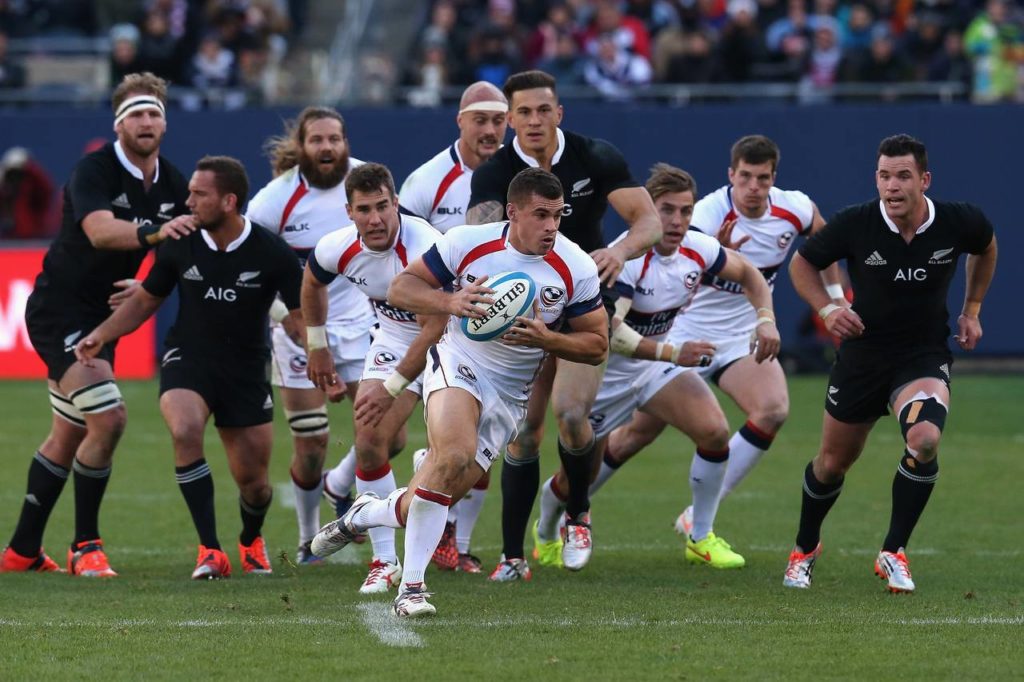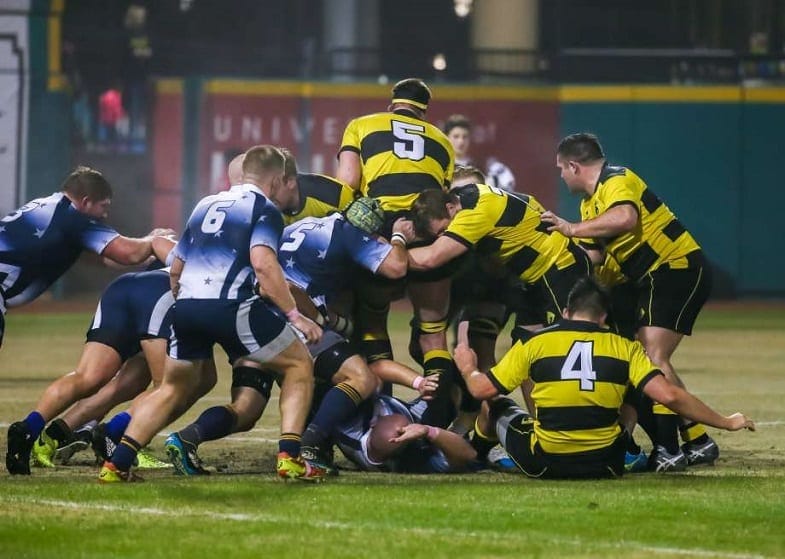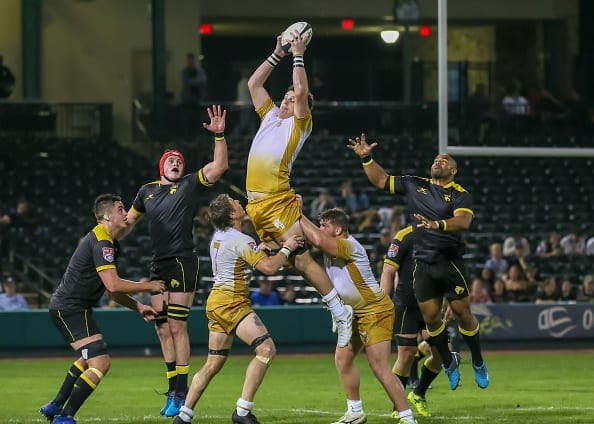Americans love their sports. It’s a well-known fact. Football, baseball, basketball, and hockey fans go to extraordinary lengths to show how much they love and support their favorite teams. Many have been known to do outlandish, crazy, risky, and sometimes even foolish things to show their support. Most will not hesitate to spend hundreds of dollars to attend games and buy merchandise.
But no matter what they do, the inspiration behind each action is the same. It’s all about the love of the game. The people behind America’s newest professional sports leaguer are hoping the love of the game will help lay a foundation for their endeavor, Major League Rugby.
History of rugby in the United States
Rugby has a long history in the United States with variations of the game dating back to the 1800s. The first-ever match of record occurred in Boston back in 1875 between two college teams, McGill and Harvard. The game’s popularity continued to spread in the years to come. By the early 1900s, international touring sides from New Zealand (1905) and Australia (1913) began making regular visits.
With a surprise win over France in the 1924 Olympic Games, it appeared as if the stage was set for rugby to become the great American sport. After all, there are few things Americans love more than sports heroes representing the country on a global stage— especially when they win.
But the Olympic committee pulled the plug on rugby after 1924 and the sport’s popularity crashed in the United States. It wasn’t until the 1960’s and 70’s that the game began to reemerge to the extent that a governing body was formed. That body, the United States of America Rugby Football Union (eventually renamed USA Rugby), has represented the country in the international rugby community where the U.S. has competed since 1976.
The game has since continued to grow in the U.S. According to numbers provided by USA Rugby, as of the 2015-16 season, there are over 2600 teams in the United States from youth level through men’s and women’s teams (senior division). There are over 34,000 registered college players, another 30,000-plus in high school, and over 29,000 in the senior division.

These numbers pale in comparison to the estimated number of high school football players (1.1 million) and college football players (70,000), but it shows that there is an interest in the sport in the United States. You could even call it a foothold.
But is there enough interest to warrant forming a professional league?
Earlier efforts at professional rugby
Rugby lovers have been trying to organize a higher competitive level of the game for years in the senior division. The Super League lasted from 1997 through 2012 with an annual competition running from 2007-2012. When it folded, the remaining teams tried to continue on in the Elite Cup in 2013. But it only lasted one season.
The Super League talked about becoming a professional entity at one point, but it never got past the “talk” stage. As early as 2012, there were reports that the American Professional Rugby Competition was going to launch in 2015 with ten teams. But it never happened.
In 2015, the National Rugby Football League was supposed to kick off with teams set to battle for the Independence Cup. But much like the APRC, it didn’t happen either.
The last attempt, PRO Rugby, was promising at the beginning. When it announced its plans in November 2015, it sounded like they had the groundwork laid out pretty well. It certainly helped that it was backed by USA Rugby and World Rugby.
Everything looked good for the first season in 2016. The five-team competition began in April and ended in July with the Denver Stampede being crowned the first (and only) PRO Rugby champions. There was talk of expansion for the 2017 season. But with rumors circulating about financial trouble and issues with USA Rugby, the league folded in January 2017.
Major League Rugby
The latest attempt at professional rugby in the United State is set to kick-off in this month with seven teams playing a ten-week regular season spanning from April into June. The best four will continue on into the postseason culminating with a championship game.

But why try it? Why try to form another professional rugby league in the U.S. so soon after one failed?
The answer to that is pretty simple (per the MLR website):
“In 2017, driven by our passion for the game, Major League Rugby came together with the mission of driving American rugby to the highest levels, as a professional sport and an avenue for young men and women to participate in sports, and learn about the values that are at the core of our game: teamwork, respect, enjoyment, discipline, and sportsmanship.”
That sounds great, but how is it different? Why is it going to succeed where PRO Rugby failed?
From what a representative of MLR told Sports Retriever, it sounds like they are taking a grassroots approach to growing the league by starting with existing clubs:
“MLR started when a group of existing clubs and local business people came together to find a better way to professionalize the game in the U.S. The goal was to build on and from the existing infrastructure with an emphasis on growing the game and on creating a sustainable long-term model.”
Teams are being established in communities with a history of support for the sport and a pre-existing player base. For example, the Glendale Raptors Rugby Club was formed in 2007 and has been one of the most successful in the country. The Austin Elite is connected to the Austin Huns (established in 1972).
Seattle’s team, the Seawolves, will draw support from a local club, the Seattle Saracens. They are connected to the Saracens Global Network run by Saracens F.C. in the UK.

The Houston Sabercats are the only team without a direct link to a local club. But the Houston area has long been home to a number of collegiate and senior division teams.
The other three teams playing in the inaugural season will be the New Orleans Gold, San Diego Legion, and Utah Warriors. Rugby United New York is already scheduled to join the league in 2019. Two additional expansion teams are expected to begin play in 2019 as well.
Investors in the teams have not been made public at this time. But MMA fighter Conor McGregor has been rumored to have an interest in the New York team.
Teams will have a salary cap of $350,000 to pay players and will be allowed no more than five international players.
Why will Major League Rugby succeed?
Part of the problem with PRO Rugby was that the league was owned and operated by one person. That is not going to be the case with MLR. Teams are not owned by a central figure with ultimate control, but by independent ownership groups operating under their own business models.
Each team has paid a bond of around $500,000 to join the league and compete. According to reports, team owners are expected to be able to operate financially for five years.
The most important thing will be making the game (and league) relevant in the American sports media market. Dean Howes, MLR’s commissioner, thinks the potential is certainly there. He said as much recently when he spoke with the Guardian:
“Across all media, in the US there is a growing awareness of rugby, an appetite just because the game has an ongoing clock, it has a great deal of appeal, it’s constant action. I think what has not yet been proven in the US is can we make rugby relevant to the sports media market. And that’s going to take teamwork.”

The league succeeded in reaching an agreement with CBS to broadcast a 13-game slate. It will include a “Game of the Week” during the regular season and the three postseason games. With the addition of ESPN as a distribution partner, all 31-games will be available for fans nationwide this season.
Along with the CBS and ESPN partnerships, teams will have local broadcast and international streaming deals.
So– they have what sounds like a sound organizational structure, financial backing, and media exposure. But what about the fans? Professional sports leagues only work if people are watching. The league stressed in a press release that the relationships with existing clubs will help establish fan bases:
“Rugby’s rising domestic growth and wide-reaching global fan base combine to create a unique environment for a professional league to succeed in the American market.
“While hundreds of local clubs have helped the sport to take hold in the US during the past decade, Major League Rugby is poised to unite these fans under a common banner as rugby enters the American sports mainstream.”
By establishing ties to their respective communities, teams can give locals a reason to come out to games. Once they learn the game, then they’ll continue to come out.
Can it work?
Sports teams are like any other business. They need time to find their audience/customer base. Of course, time is money. So, the question may inevitably come down to whether the league can turn a profit sooner rather than later.
The owners are supposed to be able to support their teams for five years. But things can happen over time that can make that easier said than done. Should MLR attract NFL fans in the spring, Major League Rugby could be the beginning of something extraordinary.












